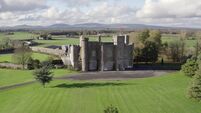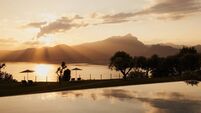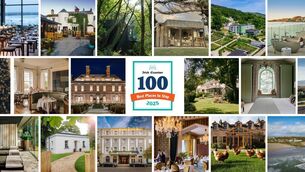The northern light
But why not make a change from the dull old routine? Stop looking southward, as we Irish always do, and turn your gaze to the Northlands. Southern Europe is worn out after the summer. Go north instead, and find fresh air, sparkling skies, wonderful food, friendly people, beautiful craftsmanship, living history. Discover Trondheim in the Norwegian region of Trøndelag. It’s a lovely place to visit at any time of year, but now, when the 24-hour sunshine of midsummer has given way to clear bright days and starlit nights, and the cold of winter is still a long way away, it’s irresistible. Who knows, you might even be lucky enough to get a glimpse of the Northern Lights?
The received wisdom is that Norway is expensive. Norway is not in the eurozone (it’s got plenty of resources of its own, including oil, so doesn’t need to be) and has its own currency, the Norwegian Krone, or crown. The current rate is about eight krone to the euro. Hotels can certainly cost a little more than here, but they are always spotless, welcoming, and offer huge healthy breakfasts, usually in buffet style. Yes, you can find restaurants charging high prices for meals, but that’s no novelty. You can also find exceptionally good value. Generally, it’s about on a par with Ireland on most levels.
Founded by Viking King Olav Tryggvason in AD 997, on the strategically sited Trondheim Fjord, Trondheim was the nation’s first capital, and continues to be the coronation city where Norway’s kings from Harald Hårfagre (872–933) to the present King Harald V have been crowned. It is also home to an internationally-renowned university, and every sixth inhabitant is a student, which makes for a youthful exuberance that you might not otherwise expect.
Don’t expect Irish-style student behaviour, though. Norwegians don’t do that. Even the end-of-exams celebrations, when traditionally students enjoy themselves for one last time before taking on the responsibilities of adulthood, never get out of control. Huge numbers congregate on the banks of the Nidelva, drinking beer and singing, but they’re mostly in bed before midnight. Calm groups of volunteers patrol the streets to ensure nobody falls in the river or gets lost going home, but they’re seldom required. When parties in the parks break up, you can see the young revellers carefully picking up every scrap of rubbish, every beer can, before taking their leave.
The old town is centred along the river where throughout the ages boats from distant lands tied up to unload their goods and take on board Norwegian timber, tar and fish. Bakklandet is Trondheim’s old quarter, and lies on the eastern side of the Nidelva, across the lovely Gamle Bybru or Old Bridge. The old wooden buildings, originally workers’ houses, have taken on a new lease of life as restaurants, pubs, craft shops and private houses, all beautifully restored and lovingly cared for. Old wharves where once sailors bargained and argued with local dealers, are now sunny and quiet, with only the occasional seagull perched, lost in thought. Trondheim is recognised as one of the best wooden cities of Europe and to sit in an ancient tavern where the water washes below through the age-old pilings, and look at the dark panelled walls while the waiter brings a tankard of lethally strong local ale, is an experience not to be forgotten. Later on, stroll to a small restaurant serving fresh fish (as you’d expect, fish features very markedly on Norwegian menus and it really is fresh, straight out of the cold northern seas), and then wander back to your hotel under starlit skies. Peace and quiet are everywhere.
A weekend just isn’t long enough for all the things to be done, places to be discovered here. A boat trip is a good way to get your bearings — it gives you a wonderful view of the town as well as Munkholmen, or Monks Island, out in the middle of the fjord. A prison and execution ground in ancient times, this island later became a monastic retreat, and is now a popular recreation spot for sunbathing and swimming in the summer season. Back on dry land, Nidaros is the world’s northernmost cathedral, and Norway’s national sanctuary which has drawn pilgrims across the ages to the shrine of Saint Olav ever since construction started in 1070. Today, many still come here to worship, traversing the ancient pilgrim paths through Denmark and Sweden.
Ringve is Norway’s national museum for music and musical instruments with a collection from around the world and some lovely music-themed gifts in their shop too. It’s perfectly sited in an old manor-farm at Lade, in the middle of Ringve Botanical Garden. A short bus ride outside town is the Trondelag Folk Museum at Sverresborg, atmospherically spread around the ruins of King Sverre’s medieval castle. Here traditional old buildings have been brought from all over Norway and laid out to show how the country’s people have lived over the centuries. Whenever a particular building or even a whole street was threatened by modernisation, the old structures were lovingly and carefully taken down, brought to Trondelag, and just as carefully reassembled. Why, oh why, don’t we do this? The Haltdalen stave church, dating from 1170, is a rarity, few churches having survived the German occupation of WWII. Within the museum building itself you can see costumes, interiors, and wonderful handiwork.
Trondheim is utterly charming and it’s impossible to resist its wiles. You find yourself slowing down, wandering here and there, returning the friendly smiles of locals, taking hours over a coffee or a beer and just watching the river flow by.
The air is so clean you wish you could bottle it, the skies are endless, and the scenery of fjordland is all around you. Next thing you know you’ll be making plans to come back in winter to try cross-country skiing, or a dogsled ride in those beckoning Norwegian woods.
The Old Quarter or Bakklandet with its quaint medieval cobbled lanes. Medieval Nidaros Cathedral. The Stiftsgården Royal Palace. Munkholmen Island. Ringve National Museum of Music. The Trondelag Folk Museum.
Beautiful Norwegian knitwear. You can see how cold the winters are here by the profusion of wool sweaters, intricately patterned stockings, gloves, mittens, hats and scarves on sale everywhere. These are age-old patterns, handed down from mother to daughter, and you shouldn’t leave without at least one piece of warm cosy history. Unique jewellery, too, including Viking designs.
KLM from Dublin or Cork via Amsterdam, from €310 (daily flights). Norwegian from Dublin via Oslo, from €226 (three days a week).
Where to stay. Rica Nidelven from €165; Comfort Hotel Park from €135, both for a double room including breakfast. City Living Scholler, from €94, breakfast extra.
Plenty of choice, from expensive to good value. Expect to pay €15-€20 for a main course in a good restaurant.









